My Industrial engineering background taught me how to apply scientific concepts to understand complex systems, designs and processes. It takes little stretch of the imagination to apply these concepts on ERP implementations – also a combination of a complex systems and processes.
Using these principles, and our experience within the ERP industry, some colleagues and I put together a guide for managers and executives on how to approach, plan and carry out an ERP project ( e-book Thinking about ERP). It explains in a non-technical and vendor-neutral way what needs to be considered, planned and executed for an ERP project to succeed.
In Part One of this series ( Thinking about ERP Part 1), I discussed the key question that the board must address about an ERP implementation – what are you trying to achieve, why, and how?
In Part 2, I want to discuss a method we have developed to think about the process, system and structural changes that an organization must make as it evolves and improves, called the ‘Dimensions of Change’ model.
The Dimensions of Change Model
Businesses can change gradually (incremental change) or by making a radical break with the past (discontinuous change). The Dimensions of Change Model can be used to describe the impact and expected result of a discontinuous change, like implementing an ERP solution. The model is based on three linked, but opposing axis:
1. The business processes that determine how an enterprise does its work
2. The people who do the work and the way they are functionally organized
3. The systems that are implemented to automate, consolidate and streamline procedures and data
This can be illustrated as a three-dimensional Cartesian surface:
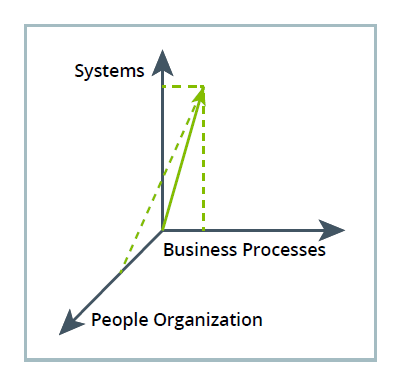
Before any changes, the organization is at coordinates (0,0,0). A discontinuous change will move the business along one, two or most likely, all three of these axes.
An ERP project is a large discontinuous change that cuts across many functional and process aspects of a business. Executives must realize that an ERP implementation will include all three dimensions of change – systems, process, and people. The relative importance of these may vary, and in their deliberations, executives can decide what limit of change or freedom, each axis is given.
Classes of ERP project
In the model, we use the term ‘degrees of freedom’ as defined in engineering as the defined dimensions in which a device or system can move. A train can only move in one physical dimension and cannot turn left or right, or go up or down. A car has the freedom to move in two dimensions. An aircraft can move in all three dimensions.
One Degree of Freedom project
A One Degree of Freedom (1DF) project is focused on only changing the system. In an ERP project, this means changing the ERP application. Business process changes will only be done because the system change demands it. People will be trained or changed to operate the system. The system will not be tailored to achieve people or organizational objectives.
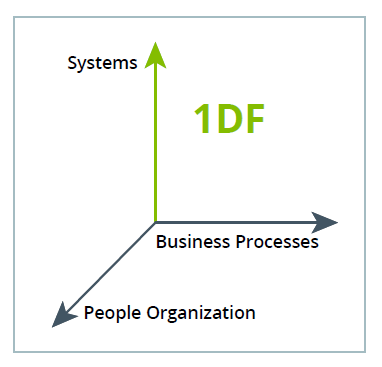
Two Degrees of Freedom project
A Two Degree of Freedom (2DF) ERP project allows the freedom to change simultaneously in two dimensions of change. There is two possible scenarios:
- In a Two Degree of Freedom ERP Systems and Business Processes project (2DF-BP), the objective is to change the business processes as well as the ERP system. The people and organization will be made to fit the new process requirements and system demands. An example is where a company wants to change the way it operates (business process change) but is unable to do so with its current system.
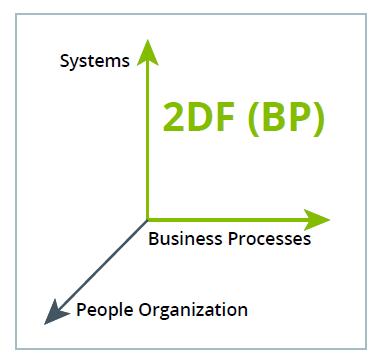
- In a Two Degrees of Freedom ERP Systems and People Organization project (2DF-PO), the objective is to change how the people work as well as the ERP system. Changes to the business process dimension will only be made to fit the new organizational and system demands.
An example is where a company changes a function such as purchasing(centralized purchasing) and requires a new system, or drastic ERP changes, to do so.
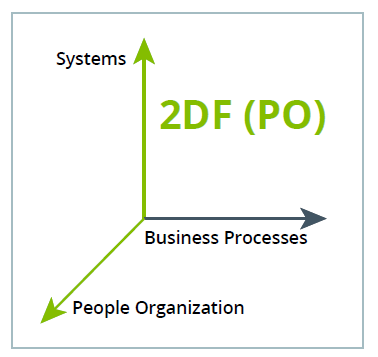
Three Degrees of Freedom project
A Three Degrees of Freedom ERP project (3DF) is where the aim is to change everything – the people and organization, business practices and procedures, and the system for doing so. An example is a company creating a new business unit, set up as an independent business with its own system, new organizational structures, and new business processes.
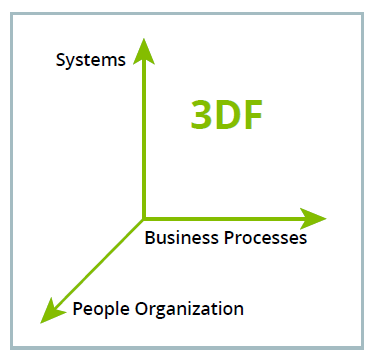
Pros and cons of One Degree of Freedom
The benefit of a 1DF project is that it is low risk, and reduces project costs. The disadvantage is that neither significant business process improvements nor major people and organizational improvements will happen. It may be seen as purely an IT project.
Pros and cons of Two Degrees of Freedom
In a 2DF project, there are different ways of reaching the desired end-state.
- A company may start a 2DF project to achieve the specified end-state in a single step.
- Or it may reach the specified end-state in two steps with two consecutive 1DF projects by making the desired changes in one dimension while limiting the others, and then make the desired changes in the second dimension while again limiting the others. For example, change business processes and then implement the ERP system, or first implement the ERP system and then change the business processes.
But, there are other issues to consider in a 2DF project.
- If you implement the ERP solution first based on current business processes, and then launch a business process improvement project, you may be very restricted in what you can do. Changing business processes after the ERP implementation may require so many changes that it seems like a second ERP implementation.
- If you first redesign the business processes and then implement the ERP application, the process redesign may be done without knowing how the ERP system works firstly, so a second business process redesign is needed.
The higher risk of a 2DF-BP project can be managed by taking longer to ensure that things are done right before go-live and that there are resources to design, verify and test the new business processes. The Seeker of Value (the executive decision-maker) needs to be much closer to the project. These requirements have time, effort and cost implications.
However, there are also major advantages. A 2DF-BP project is often a business transformation project that elevates the organization to a significantly different level in terms of competitiveness and customer positioning.
In a 2DF-PO project, the major issue is the scope of the organizational changes. It depends as well on whether the whole organization is changed or only a few functions. In all 2DF-PO projects, the primary risk is people-related.
Pros and cons of Three Degrees of Freedom
In a 3DF project, the ERP component of the project is usually subservient to the other two components. However, because a 3DF project involves changing many things simultaneously, it is potentially high-risk. The reason companies do it is because of the major transformative business benefit it will deliver.
From our experience, the excitement and the enthusiasm that goes with a 3DF can carry organizations through the many challenges that such a complex, large-scale, discontinuous change project entails. Everybody is part of something new and everybody participates. Executives are hands-on and the focus is on what needs to be done. The risks are there, but apathy and push-back are usually absent.
Business decisions about Degrees of Freedom
A 1DF ERP project in a small company and a 1DF ERP project in a large business are very different projects. The magnitude of change along the dimension is what is different. A 2DF project is more complex than a 1DF project and a 3DF project is the most complex of all.
My experience is that the increase in complexity is underestimated. Since complexity equates to risk, business executives must first think through the classification of an ERP project in terms of the Degrees of Freedom and the magnitude implications.
At the start of an ERP project, business executives need to think carefully through the objectives desired and benefits to be gained, consider the risks and the timelines, and then decide on an appropriate course of action. A key question to address is the one that is asked at the start – ‘What are you trying to achieve, and why’? The Degrees of Freedom framework helps with the ‘How’ part of the question.






